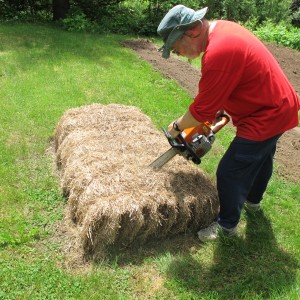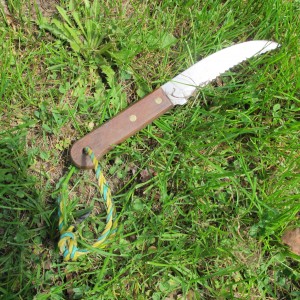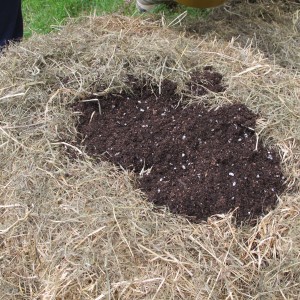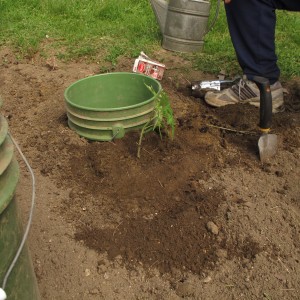Gardening with a Chain Saw
Bill Waste of Lyme, NH likes to say he gardens with a chain saw. Bill is a good humored fellow, and likes to joke. But I’ve seen him use the chain saw to get a growing bed ready to plant, so his claim is, at least partially, legitimate. What Bill was doing in the vegetable garden with his chain saw was preparing straw bales for planting.
Bill lives on a hill high above the Connecticut River in Lyme, NH with a great view, but limited space for gardening. He is surrounded by trees and the property has rocky soil that would daunt even a hard-working pilgrim. This was sheep farming country for good reason – growing vegetables is hard work in rocky soil. But each year Bill grows tomatoes, basil, pumpkins and squash. This year and last he planted his squash and pumpkins in hay bales.
If you lack good soil, or have invasive weeds that terrorize your garden plot, you might want to think about growing some vegetables in hay bales, too. It’s easy, and you don’t really have to have a chain saw. Bill explained to me that he places three hay bales side-by-side to let them season – 5 weeks is a minimum, he said. He sprinkles about a cup of organic blood meal on the top of each bale to provide nitrogen to the hay, and waters it in well – encouraging the blood meal to penetrate the hay. The hay then begins to ferment, and the blood meal provides nitrogen for the microbes that are beginning to break down the hay.
This first step of seasoning the hay is important, Bill told me, because it gives off considerable heat. Enough heat so that seeds or plants might be killed after planting. As any farmer can tell you, moist hay can occasionally generate enough heat to start a fire by spontaneous combustion. In tests I conducted some years ago, a compost pile can attain temperatures of 130 to 165 degrees Fahrenheit, and grass seed will not germinate after a few days at those temperatures.
But back to the chain saw. After 5 weeks or more outdoors, the hay bales are ready to plant. Bill uses the chain saw to carve out a planting cavity that he fills with soil. The cavity is roughly 6 by 12 inches, and 6 inches deep. I asked if I could prepare one planting hole with a knife, and he let me. I used a 6-inch long serrated knife that I got from Lee Valley tools called a root knife. It was a little slower than Bill’s chain saw, but it did the job. You could do it with a steak knife, I suppose.
After carving out the cavity, Bill fills it with potting soil and a little organic fertilizer. He plants 5 pumpkin or squash seeds in the potting soil, waters well, and steps back, ready for Mother Nature to take over. There are no weed seeds in the potting mix, and the only work that Bill needs to do is make sure the bale does not dry out. If all 5 seeds germinate, he thins out 2 plants.
Although one could grow almost anything in a hay bale, Bill recommends vines, since they can spill over the sides and stretch out across the garden. The only down side I can see is that you must be willing to let the vines grow over the lawn- which cannot easily be cut while the plants are growing. One could, I suppose, put down black plastic or mulch to keep down grass and weeds as the vines grow.
Bill is always looking for ways to save energy – his, that is. He has come up with a method of growing tomatoes that allows him to go away for a week if he wants, without letting his tomatoes suffer from lack of water. It requires access to lots of plastic buckets, which he has. Some fast food places give them away, and some building contractors have excess buckets that sheet rock “mud” comes in.
What Bill does is bury 5-gallon pails in his garden, leaving just a couple of inches above ground. These are his water reservoirs, and his tools for getting moisture down deep in the ground. Instead of surface watering every day in August when his garden is dry and thirsty, he just waters once a week by filling the buckets. The trick? He has drilled a series of eighth-inch holes in the buckets so that water leaks out to the soil after he fills them.
Around each bucket Bill plants 3 tomato plants, each just as close to the bucket as he can. The buckets have three sets of 6 or 7 small holes, each in an inverted “Y” pattern. The water leaks out in an hour or so, but it gets water where he wants it: down deep.
Each of us has a different approach to weeding, watering, planting. We figure out what works best. I doubt I will ever bury buckets for watering my garden, but if you have dry, sandy soil, you might want to. And hay bales? I’ll probably try it.
Henry’s Web site is www.Gardening-Guy.com. He can be reached at henry.homyer@comcast.net. He is the author of 5 books.






